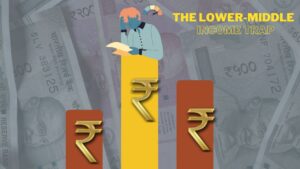A 17% credit growth in the first quarter of November 2022 means little since personal loans continue to dominate over loans to industry, particularly large industry.
 In September 2022, the CFA explained how India’s credit outflows flipped or inverted even before the pandemic set in. Personal loans overtook loans to the large industry in FY20 and continued to do so in FY21 and FY22; they overtook loans to the industry as a whole in FY21 and continued to do so in FY22. In FY23, up to September 2022, for which disaggregated data is available, the trend remains unchanged.
In September 2022, the CFA explained how India’s credit outflows flipped or inverted even before the pandemic set in. Personal loans overtook loans to the large industry in FY20 and continued to do so in FY21 and FY22; they overtook loans to the industry as a whole in FY21 and continued to do so in FY22. In FY23, up to September 2022, for which disaggregated data is available, the trend remains unchanged.
That is, bank credit is driven more by loans for consumption expenditure (for housing, consumer durables, health, and education, etc.) than by the need for investment by industry to produce more goods and services, which boosts growth and generates employment. Regardless of whether it is the world’s fifth-largest economy or the fastest-growing major economy, this is a sign of a lower-middle income trap.
Instead of acknowledging it or taking this inversion into monetary policymaking, the RBI last week sought to hype a 17% growth in credit in the fortnight ending on November 18, 2022 (over the corresponding fortnight in FY22), which the media duly obliged, to give the impression that investment is booming. The RBI statement doesn’t give disaggregate data for this (November) fortnight. Such data is available only up to September 2022, and it shows the credit growth for the industry was 1.4% for large industries and 2.7% for the industry in September 2022 over March 2022. As against this, personal loans grew by 9.4%.
The anxiety to paint a rosy picture is because credit growth has witnessed a sharp decline since FY15. For both large industries and the industry as a whole, it slipped from double digits to single digits in FY15 and continued into FY22. Higher personal loans and lower industrial loans merely suggest better utilisation of idle capacity and working capital needs, not fresh investments.
This distortion is reflected in the latest GDP (Q2) data and the industrial production data released in the past week. Manufacturing GVA (constant prices) growth fell to -4.3% in Q2 of FY23, while mining (a subset of the industry) fell to -2.8%. The growth of the core sectors—coal, crude oil, natural gas, petroleum refinery products, fertilizer, steel, cement, and electricity—remained stagnant at 0.1% in October 2022 (a 20-month low). As for the GDP growth, given the first two-quarter numbers and the overall estimation of 7% growth in FY23, the second half of FY23 would see a mere 4.1% growth, which is hardly inspiring in any case.
Unchanged credit inversion
The RBI’s September 2021 bulletin is available at lamented: “The share of large industries has been around 80 percent of the overall credit offtake to the industrial sector.” “The deceleration in credit growth in the industrial sector since 2014-15 has primarily been due to a downturn in credit growth for large industries.”
This remains unchanged.
The RBI’s database reveals that from FY11 to FY21, the large industry’s share of total credit to the industry was around 80% or more. It dipped to 76% in FY22. The monthly credit data for FY23 shows it fell further to 75.4% in September 2022. Its share of non-food credit, which used to be in the high 30s until FY15, has slipped to 19.4% in September 2022. For the industry as a whole, the credit share used to be in the high 40s (for non-food credit) during FY10–FY15. It dropped to 26.6% in FY22 (the year of 8.7% GDP growth) and then to 25.7% in September 2022.
This fall indicates that the industry is doing little to boost investment and generate employment despite the corporate tax cut of September 2019 and continued tax concessions that find expression in the “revenue foregone” statement of the budget—renamed “revenue impact of tax incentives” after FY16.
The only silver lining is the MSME sector, which employs approximately 25% of the workforce, contributes 30% to GDP, and accounts for 48% of exports. Having fallen drastically and consistently from 28.4% of the total credit to industry in FY08 to 16.8% in FY22, its share went up to 24.6% in September 2022. This augurs well for this sector, which took a big hit because of a series of man-made disasters since 2016—demonetization, GST, and the lockdown. But this change should not be seen in isolation but in the context of the overall fall in credit to the industry.
In the meantime, the share of personal loans keeps rising. From less than 20% of total non-food credit in FY15 to 28.6% in FY22, it has risen to more than 29% in September 2022 (FY23), which is not a good sign for an economy that is in an “Amrit Kaal” and aspires to be “developed” by 2047.
Centre for Financial Accountability is now on Telegram. Click here to join our Telegram channel and stay tuned to the latest updates and insights on the economy and finance.
